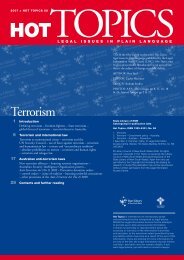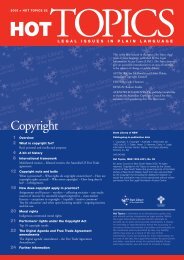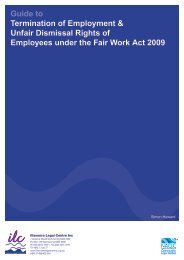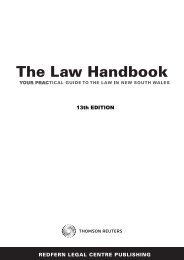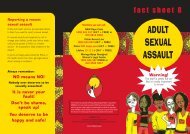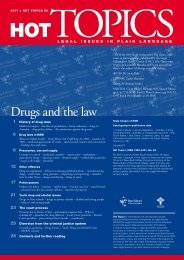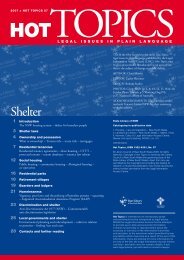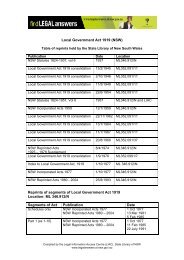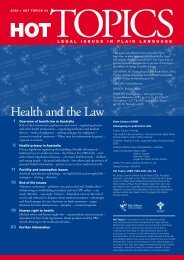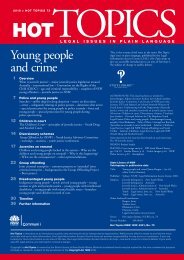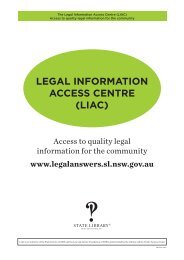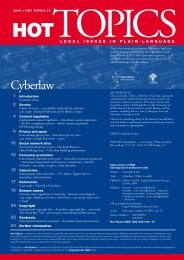Aboriginal people and the law - Legal Information Access Centre
Aboriginal people and the law - Legal Information Access Centre
Aboriginal people and the law - Legal Information Access Centre
You also want an ePaper? Increase the reach of your titles
YUMPU automatically turns print PDFs into web optimized ePapers that Google loves.
2 <strong>Aboriginal</strong> <strong>people</strong> <strong>and</strong> <strong>the</strong> <strong>law</strong> 49• When sentencing an <strong>Aboriginal</strong> person, <strong>the</strong> Court cantake into account <strong>the</strong> hardship <strong>and</strong> disadvantagecaused by <strong>the</strong>ir background.• In prison, <strong>Aboriginal</strong> <strong>people</strong> are not entitled to betreated differently from <strong>the</strong> o<strong>the</strong>r inmates in respectof classification, segregation, leave of absence orparole. There is usually at least one <strong>Aboriginal</strong> personon <strong>the</strong> Parole Board, although <strong>the</strong>re is no specificrequirement for this.Women, children <strong>and</strong> young <strong>people</strong>There are no provisions of <strong>the</strong> criminal <strong>law</strong> that relatespecifically to <strong>Aboriginal</strong> women or to <strong>people</strong> under <strong>the</strong>age of 18. For information regarding children <strong>and</strong> <strong>the</strong>criminal <strong>law</strong> see chapter 8, Children <strong>and</strong> young <strong>people</strong>.<strong>Legal</strong> assistance[2.180] <strong>Aboriginal</strong> legalservices<strong>Aboriginal</strong> legal services were established in<strong>the</strong> 1970s largely in response to <strong>the</strong> overrepresentationof <strong>Aboriginal</strong> men in <strong>the</strong>criminal justice system, in particular due tomisuse of <strong>the</strong> Summary Offences Act 1988(NSW) (which covers such things as vagrancy<strong>and</strong> swearing in a public place).In 2006 <strong>the</strong> six <strong>Aboriginal</strong> legal services inNSW <strong>and</strong> ACT were amalgamated to form asingle service, called <strong>the</strong> <strong>Aboriginal</strong> <strong>Legal</strong>Service (NSW/ACT) Limited (ALS (NSW/ACT)), which continues to be an <strong>Aboriginal</strong>community controlled organisation. Thereare 23 offices in NSW <strong>and</strong> ACT in metropolitan<strong>and</strong> regional areas.ALS (NSW/ACT) provides legal advice<strong>and</strong> court representation for <strong>Aboriginal</strong> <strong>and</strong>Torres Strait Isl<strong>and</strong>er men, women <strong>and</strong>children in criminal <strong>law</strong> <strong>and</strong> children’s care<strong>and</strong> protection matters.Women's legal servicesAn <strong>Aboriginal</strong> women’s legal service, WirringaBaiya, was established in 1996 inrecognition of women’s special legal needs,particularly in relation to domestic violence,sexual assault, care <strong>and</strong> protection, <strong>and</strong>custody matters. The Indigenous Women’s<strong>Legal</strong> Program at Women’s <strong>Legal</strong> ServicesNSW was established in 1996 to respond to<strong>Aboriginal</strong> women’s civil legal needs acrossNSW (see Indigenous women <strong>and</strong> <strong>the</strong> <strong>law</strong> at[2.240]).See Contact points at [2.580] for a full list of <strong>Aboriginal</strong><strong>Legal</strong> Services in NSW.[2.190] Office of <strong>the</strong>OmbudsmanThe NSW Ombudsman has a designated<strong>Aboriginal</strong> liaison officer to deal with complaintsfrom <strong>Aboriginal</strong> <strong>people</strong>.[2.200] Trial <strong>and</strong> sentencingAll persons are entitled to be tried inindictable criminal matters by a jury of <strong>the</strong>irpeers (Criminal Procedure Act 1986 (NSW),s 131). The reference to “peers” does not,however, entitle a person to be tried only by<strong>people</strong> of <strong>the</strong>ir own race or religion. Thejury rolls are established by <strong>the</strong> selection ofnames at r<strong>and</strong>om from <strong>the</strong> electoral rolls(Jury Act 1977 (NSW), s 12). <strong>Aboriginal</strong><strong>people</strong> are not entitled to trial by an <strong>Aboriginal</strong>judge or magistrate.For details about trial procedure, see chapter 14, Court.



